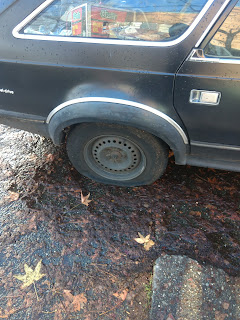See?
Just ignore the trash. That's what I've been doing and it's worked out well so far.
Everything's lined up, the AC idler pulley is in place and ready, and the PS pump is wearing its belt. Once the stuffing and tape is replaced with the stuff that should be in/on the various openings, we'll be in business.
Beyond mashing the pump into the reservoir, fighting the car mounting studs, and pressing the pulley on, I also got the trans off the wood blocks it's been sitting on and onto the caveman dolly I bashed together (from other wood blocks). Seems to work okay so far; hopefully it's cool with the sustained load.
After that, I got a few holes drilled through the hump for some center console mounting brackets. Figured now is the time to do it, since soon there's going to be a transmission living underneath.
Since I was in the neighborhood, I pulled the Gremlin's original throttle cable in favor of one I yanked out if an XJ. It's also a lot easier to get to when there's not a motor in the way. I suspect the section of cable from the firewall to the pedal may be about an inch longer than a perfect fit, which should be easy enough to attend to if it proves to be true.
Eagle's doing fairly well, though brief groans during certain types of turns has turned into clunks that you can feel through the steering wheel. Visual inspection confirmed that the pitman arm is about done, though I expect it'll last until the replacement arrives on Thursday. There's not been any binding or resistance in the steering, so it should be good if I don't do anything wild.
Aside from Eagle times, the agenda is: install motor, bolt stuff to it (AC compressor, alternator, etc), install radiator, run hoses, route trans cooler lines, and install the trans. Simple enough, right?

















































